How the
College Of New Jersey
Relates to
the
Heresy of
Decisional Regeneration
![]()
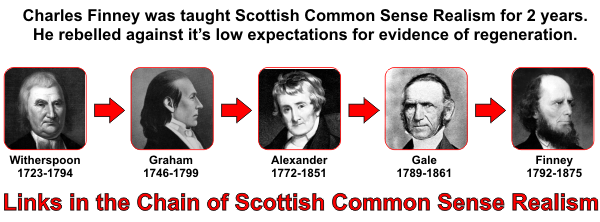
New Light Calvinist Presbyterians founded the College of New Jersey, in 1746, to train ministers and other public leaders in an environment sympathetic to New Light Calvinist methods and theology. Relocated in Princeton (and renamed Princeton) in 1756, it quickly attracted students from all regions of the country and gained a reputation for training leaders for public life. For example, one-sixth of the members of the Constitutional Convention were Princeton alumni.
The college was necessary because Harvard and Yale discouraged (for example, David Brainard was expelled from Yale in 1742 for pro-Awakening sentiments) young ministers from participating in the First Great Awakening. The College of New Jersey was established as a replacement for William Tennents Log College, which had been starved to death by Old Light Calvinists ministers and congregations who did not accept graduates as qualified ministers.
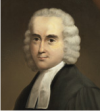
John Dickinson (1688-1747), 1st President of the College of New Jersey (1747)
Dickinson was Presbyterian minister that worked side by side with George Whitefield in the First Great Awakening. Like Jonathan Edwards, he was a vocal supporter of the New Light Calvinist view of supernatural regeneration and the indwelling of the Holy Spirit while being careful to discriminate between true and false conversions. He would have vehemently condemned John Witherspoon's view of regeneration as a psychological "tipping point" after a sufficient number of "truth impressions". Dickinson believed regeneration was a change of character, not merely a change of mind. That is why he disagreed with the idea that ministers merely needed to agree to the Westminster Confession to qualify for the ministry. He argued for the strict examination of the ministerial candidate's religious experience for evidence of regeneration and the indwelling of the Holy Spirit.
In 1739, Dickinson became one of the leaders of a movement to found a “seminary of learning” for the middle colonies. He was disappointed by Harvard’s and Yale’s opposition to New Light Calvinists and by Yale’s harsh treatment of his young friend, David Brainerd, a student who was dismissed because he gave outspoken opposition to the faculty’s conservative religious views.
When the split of New Side and Old Side Presbyterians took place in 1741-1745, he stood firmly with the New Side Presbyterians.
He considered the only other college in the colonies, William and Mary of Virginia, too Anglican and too far away. So, with the help of three fellow pastors (Ebenezer Pemberton, Aaron Burr Sr., and John Pierson) and three laymen from New York City (William Smith, Peter Van Brugh Livingston, and William Peartree Smith), he secured a royal charter for the College of New Jersey dated October 22, 1746. The first trustees announced Dickinson’s appointment as president in April 1747.
Dickinson was arguably the most distinguished Presbyterian minister in the colonial period, with an international reputation as a theologian second only to Jonathan Edwards, who like him, defended the Great Awakening while criticizing revivalistic excesses.
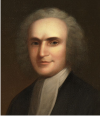
Aaron Burr Senior (1716-1757), 2nd President of the College of New Jersey (1748-1757)
Burr was Presbyterian minister that worked side by side with George Whitefield and the Tennents in the First Great Awakening. He was mentored by Jonathan Edwards, and as such, was a vocal supporter of the New Light Calvinist view of supernatural regeneration and the indwelling of the Holy Spirit while being careful to discriminate between true and false conversions. He would have vehemently condemned John Witherspoon's view of regeneration as a psychological "tipping point" after a sufficient number of "truth impressions". Burr believed regeneration was a change of character, not merely a change of mind.
Burr founded the College of New Jersey along with Jonathan Edwards and Jonathan Dickinson to be an institution sympathetic to New Light Calvinism.
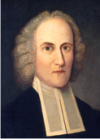
Jonathan Edwards (1703-1758), 3rd President of the College of New Jersey (1758)
Jonathan Edwards was made President in 1758, a few weeks later he died from a small pox innoculation. It is ironic that Edwards died from a medical procedure that was a harbinger of a change in the way man would see the sovereignty of God as metaphysical as apposed to supernatural. He was a vocal supporter of the New Light Calvinist view of supernatural regeneration and the indwelling of the Holy Spirit while being careful to discriminate between true and false conversions. He would have vehemently condemned John Witherspoon's view of regeneration as a psychological "tipping point" after a sufficient number of "truth impressions". Edwards believed regeneration was a change of character, not merely a change of mind. Jonathan Edwards' son was one of the New Light Calvinist ministers that left the College of New Jersey when John Witherspoon changed the salvation theology to Scottish Common Sense Realism in 1768.
In 1812, most New Light Calvinist ministers in America were Hopkinsian and Bellamite, the two theologies descended from Jonathan Edwards' theology. But 10 years after Edwards death, John Witherspoon had introducedScottish Common Sense Realism to the College of New Jersey. the ministers educated in Scotish Common Sense Realism would start Princeton Theological Seminary in 1813. Within 50 years, all American seminaries would adopt Scottish Common Sense Realsim. By the Civil War, Hopkins and Bellamy were footnotes in religious history.
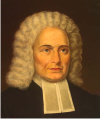
Samuel Davies (1723-1761), 4th President of the College of New Jersey (1759-1761)
Davies was a Presbyterian minister that had an orthodox view of salvation. Like Jonathan Edwards, he was a vocal supporter of the New Light Calvinist view of supernatural regeneration and the indwelling of the Holy Spirit while being careful to discriminate between true and false conversions. He would have vehemently condemned John Witherspoon's view of regeneration as a psychological "tipping point" after a sufficient number of "truth impressions". Davies believed regeneration was a change of character, not merely a change of mind.
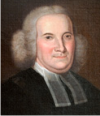
Samuel Finley (1715-1766), 5th President of the College of New Jersey (1761-1766)
Finley was educated at William Tennants Log College, was fervently pro-Awakening, and was one of the founding trustees of the College of New Jersey to provide a New Light Calvinist alternative to the Old Light Yale and Harvard.
Finley was a Presbyterian minister that had an orthodox view of salvation. Like Jonathan Edwards, he was a vocal supporter of the New Light Calvinist view of supernatural regeneration and the indwelling of the Holy Spirit while being careful to discriminate between true and false conversions. He would have vehemently condemned John Witherspoon's view of regeneration as a psychological "tipping point" after a sufficient number of "truth impressions". Finley believed regeneration was a change of character, not merely a change of mind.

John Blair (1720-1771), 6th President of the College of New Jersey (1767-1768)
Blair was a Presbyterian minister that had an orthodox view of salvation. Like Jonathan Edwards, he was a vocal supporter of the New Light Calvinist view of supernatural regeneration and the indwelling of the Holy Spirit while being careful to discriminate between true and false conversions. He would have vehemently condemned John Witherspoon's view of regeneration as a psychological "tipping point" after a sufficient number of "truth impressions". Finley believed regeneration was a change of character, not merely a change of mind.
Had he known Witherspoon would change the understanding of evangelical salvation in America from a supernatural activity of the Holy Spirit to metaphysical material causation of psychology, he would no doubt have fought Witherspoon as hard as he fought the marauding indians who once threatened his family.
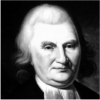
John Witherspoon (1723-1794), 7th President of the College of New Jersey (1768-1794)
If you read John Witherspoon’s view of regeneration, you’ll find the version of Scottish Common Sense Realism he brought to Princeton put regeneration into a subservient position to moral persuasion: “This conviction of the obligation of the divine law, so essentially connected with, or rather so necessarily previous to, an acceptance of the imputed righteousness of Christ, is evidently founded upon the relation of man to God, as a creature to his Creator. This relation then continues, and must continue, unchangeable; therefore the obligation founded upon it must be unalienable; and all those who have once been sensible of it, must continue to be so, unless we suppose them blinded to the knowledge of God as Creator, by the discovery of his mercy in Christ the Redeemer. But this is absurd; for the subsequent relation of a sinner to God, as forgiven and reconciled through Christ, never can take away, nay, never can alter his natural relation as a creature, nor the obligation founded upon it.”
No puritan would link illumination of Law Works with regeneration so completely. Sensibility of the obligation of divine law is not evidence of regeneration, and to think so is to make acceptance of the truth of scripture as tantamount to saving faith. This is what Finney rebelled against when he was taught for two years by George Washington Gale, and this is the error that caused the BEST system to be changed to the BIST system after the Civil War.
Witherspoon's influence over the evolution of the American New Light Calvinist decision for Christ can not be understated. If the philosophy of Friedrich Nietzsche could be said to be the basis for Nazi ideas of the "power of the will", the theology of Witherspoon was the philisophical influence that resulted in the New Light Calvinist "metaphysical moral influence" decision for Christ. This was the rational for the Inquiry Room changing from BEST system to BIST system after the Civil War, which incidently, was NOT IN ANY WAY CONNECTED TO CHARLES FINNEY. Charles Finney continued to use the BEST system till the day he died in 1875.
Finney was indirectly influenced by Witherspoon though. Witherspoon taught William Graham (1746-1799), and Graham taught Archibald Alexander (1772-1851) Scottish common Sense Realism, and Alexander taught George Washington Gale (1789-1861), and George Washington Gale taught Charles Finney (1792-1875) to prepare him for the ministry. Finney rejected the idea that regeneration was not immediately discernable and questioned the lack of supernatural activity (apart from the energizing of Scripture) of the Holy Spirit inherent in Scottish Common Sense Realism. This rejection caused him to form his own theology more in line with that of Samuel Hopkins that stressed the immediate experience of regeneration. Unfortunately, almost all moden Calvinists do not know that Finney based his expectation on immediate experience of regeneration on a predeterminist premise with consecutional saving faith.
If you are serious about understanding how Christian salvation change so quickly, that it, before the Civil War supernatural regeneration and the indwelling of the Holy Spirit to after the Civil War, saving faith as evidenced by believing Scipture, please read the complete text of Witherspoon's Practical Treatise On Regeneration with commentary.
Here is a short biography of John Witherspoon:
John Witherspoon’s father was a Presbyterian minister. He was a child prodigy, entering Edinburgh University at age 13 and graduated at 16. He was licensed to preach in 1743 and married Elizabeth Montgomery (a minister’s daughter) in 1745. By 1750, the evangelical movements of George Whitfield, John Wesley, and others threatened the stability of church life.
The Scottish Calvinists were divided into four camps:
1) The “Scholastic Calvinists” were known for their rigid allegiance to the Westminster Confession of Faith and emphasis on predestination.
2) The “Evangelical Calvinists”, who did not deviate from the Confession, were known as “New Light” Calvinists because they asked sinners to immediately repent and submit to God. Witherspoon considered himself to be in this group, publically identifying himself as sympathetic with the controversial James Hervey, who was a “Holy Club” alumnus with George Whitefield.
3) “Liberal Calvinists” who valued societal respectability and the social benefits of Christianity, eschewing confessional and doctrinal commitment, but who were in some ways, devout.
4) “Arians” who reduced Christianity to external morality and treated subscription to the Westminster Confession as simply a formality.
Witherspoon was head of the Calvinist “Popular Party”(as apposed to the Calvinist “Moderate Party”), which consisted mostly of New Light Calvinists until he left for America in 1768.
When he came to Princeton as it’s seventh president, it was thought he would bring healing between the Old Light and New Light Calvinists, who had split into competing churches in many places since the First Great Awakening. The way he did this was to replace the “religious affections” emphasis and supernatural idealism ideas of Jonathan Edwards (Edwards had served as President briefly 10 years before) with Scottish Common Sense Realism. The transformation quickly caused all four of the faculty to resign in the first year. Witherspoon’s theology replaced the supernatural explanation of regeneration with a metaphysical moral persuasion perspective. He thought the American New Light Calvinist approach of Jonathan Edwards, Joseph Bellamy and Samuel Hopkins would inevitably lead to skepticism or materialism. He thought Scottish Common Sense realism provided a more defensible position against infidelity because it was consistent both with reality and Christian orthodoxy.
Witherspoon was the only college president in America to take an active role in the American Revolution, and was the only minister among the 56 signers of the Declaration Of Independence. British troops burned him in effigy along with General Washington. Princeton closed during 1776-77 and suffered because of Witherspoon’s preoccupation with congressional matters. The campus was occupied on and off for five and a half years by both American and British troops.
Witherspoon was an active member of congress, serving on more than a hundred committees through his tenure, debating frequently on the floor. He also served twice in the New Jersey state legislature
Witherspoon personally graduated 114 pastors and 13 college presidents, laying a foundation for the replacement of the American New Light Calvinism of Samuel Hopkins and Joseph Bellamy with Scottish Common Sense Realism. In 1812, most American New Light Calvinist ministers still identified with Hopkins and Bellamy. But in 1813, Princeton added a theological seminary – that was the beginning of the end for Bellamy and Hopkins theology. By the Civil War, the BEST system was being replaced with the BIST system in the Inquiry Room.
Witherspoon taught, “The moral sense is precisely the same thing with what, in scripture and common language, we call conscience. It is the law which our Maker has written upon our hearts, and [so] both intimates and enforces duty, previous to all reasoning.” Witherspoon’s goal was to bridge the gap between the rationalism of John Locke and the supernaturalism of Jonathan Edwards. John Locke did not believe in supernatural regeneration and the indwelling of the Holy Spirit. He taught that saving faith was merely "bare faith" in the facts of the gospel. Jonathan Edwards recognized scripture as a means of grace, but that regeneration was a supernatural, immediate activity of the Holy Spirit not necessarely connected to the moral persuasion of scripture. Witherspoon’s point was that reason and revelation are compatible—that the moral philosophy derived through reason is consistent with that derived from revelation.
In just 10 years from the death of Jonathan Edwards, John Witherspoon (1729-1794) was made president (1768) and brought with him from Scotland a theology that would undermine the supernatural-based theology of Jonathan Edwards and replace it with a metaphysical view. He replaced the supernatural explanation of religious affections with Scottish Common Sense Realism, specifically opposing the lingering elements of New Light Edwardseanism in the curriculum.
Scottish Common Sense Realism was a way of restoring the Puritan means of grace and law works without the need of embarrassing religious affections. It made the pre-regeneration repentance and submitting to God more Catholic and less evangelical, blurring the line between duty faith and saving faith. Witherspoon’s influence cannot be understated. He was the only clergyman to sign the Declaration of Independence. Witherspoon made evangelical Christianity acceptable to the educated classes by metaphysicalizing the workings of the Holy Spirit.
The inculcation of students with Scottish Common Sense Realism in the College of New Jersey, Princeton, and by the Civil War, virtually ALL SEMINARIES, completely changed New Light Calvinist evangelism methods and theology. In 1812, almost all New Light Calvinists were Hopkinsians and Bellamites. In 1813, Princeton Theological Seminary was established. Within 50 years, Scottish Common Sense Realism had infected New Light Calvinism with a psychological view of regeneration. By 1914, the purpose and meaning of the Inquiry Room had changed from examining penitents for a change of character (the BEST system) to having penitents agree with salvation scriptures (the BIST system). Belief of Scripture was seen as evidence of saving faith and by the end of the century, so most ministers no longer examined penitents for a change of character. It was no great stretch for Billy Sunday to eliminate the Inquiry Room altogether, since penitents presumably came forward because they believed the salvation scriptures inherent in the altar call. The Scottish Common Sense Realism "decision for Christ" in 1814 evolved into the heresy of decisional regeneration in 1914. There was no more need for supernatural regeneration and the indwelling of the Holy Spirit.